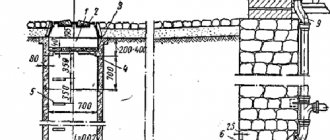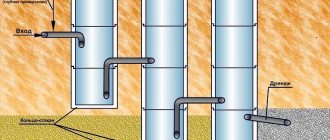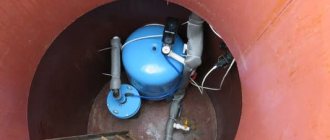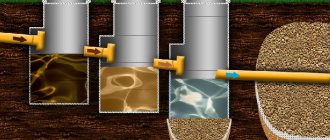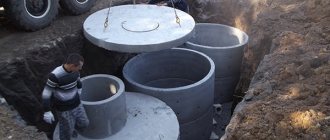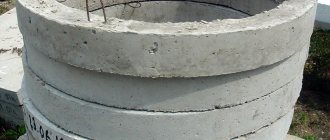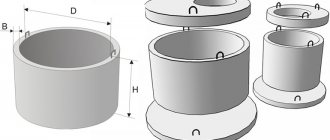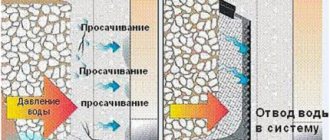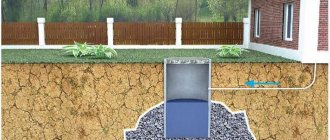Waterproofing a septic tank made of concrete rings is a mandatory measure, thanks to which it will be possible to guarantee long-term and high-quality service of the entire structure, reliably protecting it from the destructive effects of moisture. Properly performed waterproofing will make it possible not only to extend the life of the septic tank, but also to protect the environment from leaks.
A correctly selected sealant, taking into account all the features and nuances, will protect the structure from corrosion, destruction, and cracks. The concrete will not erode or crumble, and the reinforcement frame will remain intact. The septic tank will not turn into a source of infection and odor on the site, and will not experience the negative influence of groundwater - sealing will protect the structure completely, both inside and outside.
Purpose and types of waterproofing of a septic tank
Waterproofing concrete rings for a septic tank is a task that can be accomplished using a variety of materials, means, and technologies. But first you need to understand why this is needed and what basic requirements the sealing must meet.
In concrete, under the influence of water, a lime leaching reaction begins, which leads to the appearance of growths on the surface of the monolith. Soil and groundwater often contain magnesium salts, which also destroy concrete. When interacting with lime, these salts form calcium sulfoaluminate, which is subsequently washed away by water from the monolith, weakening and destroying it.
In addition, groundwater contains carbon dioxide, which interacts with calcium oxide hydrate and provokes the onset of deforming processes in concrete. In winter, getting into the pores and microcracks of the surface, water freezes there into ice, which increases in volume and bursts the monolith, causing cracks and faults.
It is worth remembering about the reinforcement - it must be completely protected on all sides by concrete, but when pieces of material begin to spill out and the metal is exposed, it begins to corrode quite quickly. The level of strength and reliability of the structure decreases and soon the ability of the concrete ring to perform its functions is called into question.
Sealing a septic tank from concrete rings is designed not only to protect the structure, but also to work in the opposite direction: to protect the environment from the contents of the septic tank. Dirty water in the ground can become a source of infections, unpleasant odors, and cause the spread of harmful microorganisms. Not only is this dangerous to human health, but it may also entail certain penalties from regulatory organizations.
When waterproofing a septic tank made of concrete rings from steam, moisture, groundwater and other negative influences, special attention is required to protect the bottom of the first well at the junction with the lower ring. The seams between the rings must also be treated. There are many materials to improve the performance properties and protection of concrete rings.
Main types of waterproofing materials:
- Coating compositions – containing bitumen: create a film on the surface that guarantees impermeability
- Sprayed products - they are usually used to treat the outside of rings using special equipment
- Injection compositions - can be made on the basis of epoxy resin, polyurethane, minerals, but are considered too expensive for treating septic tanks
- Materials in rolls - they are used to perform adhesive waterproofing: usually it is bitumen-polymer or bitumen mastic applied to a fabric base (fiberglass, geotextile)
- Penetrating substances - create insoluble crystalline hydrates in the surface layer of concrete, which act as a barrier
Required materials and tools
Waterproofing of concrete rings for a septic tank is carried out after preparing tools and materials. The following materials are used to process the structure outside and inside:
- roofing felt and polymer mixture;
- hot or cold mastic;
- deep penetration waterproofing in the form of impregnation or compositions for injection;
- silicone for sealing joints.
As for the tools, the work requires a drill with a special attachment for mixing the solution, a container for its preparation, and a metal brush. To apply liquid compositions, use a roller or paint brush. Before work you need to put on special clothing and a respirator.
A hot bitumen mixture will not last very long, since under the influence of pressure and an aggressive environment it will quickly crack.
Sprayable water barrier
Waterproofing a septic tank made of concrete rings, made using this method, makes it possible to create an impenetrable seamless layer. Special emulsions with water-repellent properties are sprayed under high pressure onto the surface of the concrete, due to which the composition enters the pores and cracks of the monolith, filling and closing them completely.
The composition of this type of product includes a polymer composite, water and various fillers.
The main advantages of sprayed waterproofing:
- Speed and ease of work
- Minimum drying time of the layer
- High level of adhesion to concrete monolith
- Long service life - up to 20 years with preservation of all characteristics
- Resistance to sudden temperature changes
- Improving the properties of concrete, strengthening the septic tank structure itself
Such insulation guarantees adhesion to the concrete surface at the molecular level, reliably protects reinforced concrete materials, and can be applied to old layers of various means.
Polymer-cement
Construction of an overflow cesspool made of concrete rings.
A relatively inexpensive and frequently used method is coating or polymer-cement waterproofing.
It is carried out using mixtures of cement with special polymers or liquid glass.
Polymer cement waterproofing is as easy to implement as bitumen waterproofing, but lasts much longer.
Coating compounds for protection
It is advisable to take care of waterproofing before making a septic tank from concrete rings. But even if the application of sealant was not initially envisaged, it can be applied later (and will definitely have to be renewed during operation). Coating compounds can be applied to structures of any shape and configuration; no special knowledge, tools or mechanisms are required to perform the work.
Classification of water-repellent materials
Water-repellent materials of this type are divided into 4 main groups depending on the base: cement, bitumen, polymers, sealing mastics. All substances are designed to fill the smallest pores and irregularities, remove defects and make the monolith completely invulnerable to moisture. Some formulations may contain toxins, so personal protective equipment must be used during the work process.
Sealing with coating materials is carried out either the entire structure or part of it: when underground groundwater lies deep, it is enough to protect the lower ring of the septic tank; if it is high, they protect the entire structure. Bitumen-polymer mastic is considered more durable, which creates an elastic, durable layer that works in any conditions.
The mastic is applied easily in a uniform layer, it is inexpensive, in which case the layer of the mixture can always be renewed. To apply the coating composition even in the most inaccessible places, you do not need any special tools. The mastic can be intended for application using a cold method (diluted with a solvent) or a hot method (first the composition is heated to +160 C, then processed).
Mastic can be one/two-component. The main substance is always a polymer or bitumen; additional substances can be rubber and polyurethane (they give elasticity to the substance, apply well, are not afraid of various external factors), oils (do not harden, resist frost, heat) and others.
Application rules
When thinking about how to make a sealed septic tank from concrete rings, you need to remember the importance of following technology when performing any work. Coating waterproofing is applied to the surface after treating the seams between the rings and the points where pipes enter the structure.
The main stages of treating a septic tank with mastic:
- Thorough cleaning of the surface, eliminating defects with putty and sealant.
- Distribution of the primer layer over the surface (bitumen primer is suitable) - prepared according to the instructions, applied with a brush in a layer or two with a break for each layer to dry. The last layer should dry for a day.
- Apply mastic with a brush in two layers with a break for each to dry. Additional processing of areas requiring repetition or layer correction.
A sealed structure is obtained using conventional bitumen mastic, which is cheaper than compositions with polymer additives. Bitumen adheres well to concrete, is not afraid of chemicals and moisture, but does not tolerate severe frosts. Typically the layer lasts 5-7 years.
Reasons for waterproofing concrete rings
The main reasons why such ring wells require mandatory waterproofing are as follows:
- Water, especially the aggressive environment of septic tanks, leads to leaching (destruction) of concrete;
- Corrosion of unprotected reinforcement frame;
- It is possible that the well will overflow with rising groundwater. In addition to overflowing the well, they also lead to the destruction of concrete structures;
- Seepage of fecal fluid from inside a well into the soil. This causes it to become infected. An unpleasant odor appears in the area around it.
For these reasons, it is more profitable to seal the structure than to periodically carry out major repairs.
Plaster under pressure
This option allows you to create a dense, uniform layer of waterproofing, but is quite expensive. Waterproof cement that does not shrink is supplied under fairly high compressed air pressure. To perform the work, special drying cement is used. All activities are carried out at a temperature of at least +5C, the layer is laid in two layers, each 5-10 millimeters thick.
Each subsequent layer is applied after the previous one has set (which sometimes requires up to 14 days); to eliminate the risk of cement cracking, it must be moistened every 3-4 hours in hot weather and 12 hours in cool weather.
Septic tanks
Most often, septic tanks (overflow wells) have such a concrete structure. They consist of 2-3 tanks connected to each other by overflow pipes. Septic tanks are designed to collect sewage from a private home. Insoluble impurities of such wastewater settle at the bottom of the first reservoirs. The water, cleared of impurities, is poured by gravity through a pipe with an inclination into the next tank. In this case, the solid and liquid phases of the wastewater are separated. The last, filtering, tank has no bottom.
Displacement of the well rings can cause destruction of the insulation between them. The upper ring is subject to the most damage due to soil freezing. Therefore, when installing each one, it is necessary to provide for its fastening with neighboring ones: brackets, rings with locks, etc.
If displacement cannot be completely prevented, it is worth paying attention to those types of insulation that are not afraid of such movement.
Penetrating or capillary waterproofing
This method is considered the most reliable and durable. The materials are applied to the concrete surface, enter the structure of the monolith, crystallize and completely fill the voids. Thus, cracks are eliminated, the top layer of concrete is strengthened, the composition becomes one with the monolith, does not allow water to pass through, and compacts the structure.
Crystal hydrates from the material are not washed out, do not decompose, and guarantee a long service life. On the surface of the concrete, a layer of substance only fixes the active chemical components necessary to provide a layer of waterproofing. Some manufacturers say that after the reaction is complete, the layer can even be removed.
Penetrating waterproofing is applied to a surface that has been thoroughly cleaned mechanically or chemically. Next, the concrete is watered with water under pressure. The seams are processed first (it is best to do this during the installation of the rings), then the entire monolith. It is better to prepare the mixture in parts, in strict accordance with the instructions. Mix the substance with water using a drill with a spiral nozzle, apply the composition with a spray, brush or roller in at least 2 layers at intervals of 2-3 hours.
The coating is up to 2 mm thick, the consumption of the substance is within 1 kg/m2. The following mixtures are usually used: “Kalmatron”, “Lakhta”, “Penetron”, “Hydro S”. If you treat the structure inside and out, it will be completely sealed and durable. Today, waterproofing a septic tank made of concrete rings from the inside with liquid glass is also actively used, which also guarantees a high level of protection.
Penetrating chemical compounds
Many experts in the field of protection of reinforced concrete structures consider this type of concrete protection to be the best of all existing ones. Penetrating waterproofing is performed using compounds with specially developed physical and chemical properties. Chemical mixtures penetrate into the concrete mass of the structure, filling pores and voids with subsequent crystallization. This process has a prolonged effect: an increase in the humidity level initiates its slowdown, and a decrease, on the contrary, accelerates it. This allows waterproofing compounds to quickly fill cracks that appear in the thickness of concrete.
Significant disadvantages of penetrating waterproofing include its high cost and labor intensity. Concrete surfaces of well rings require careful preparatory measures and preliminary treatment.
Materials for sealing inter-ring seams
The most vulnerable point of a septic tank is considered to be the seams between the rings, where leaks often appear. To seal seams, polymer cement with hemp/jute rope, rubber gaskets with bentonite granules, rubber tape seals, reinforcing fabric, etc. are used. Penetrating auxiliary mixtures that are used to treat seams and all pipe entry points have proven themselves to be effective.
To seal a damaged seam (crack), a groove up to 3 centimeters deep and the same width is made along it using a hammer drill or grinder.
The groove is cleaned of debris and dust, moistened, coated with a primer, allowed to dry, and then the recess is filled with an auxiliary composition. Then the area is treated with the main waterproofing agent.
To eliminate leaks, special materials are used that are capable of simultaneously expanding and setting. The surface around the leak is cleared, a sample is made with a hammer drill, a plug slightly larger than the sample is made from the mixture, pressed into place and held until it sets.
Seam processing
Waterproofing is impossible without reliable reinforcement of the seams. Several techniques are used for this.
- Using bentonite cord. It is installed at the joint of the concrete ring. Special plates will protect the seam from moisture penetration. Unlike cement, the cord provides slight mobility of the system during soil shifts without compromising the tightness of the structure. The plasticity of the material allows the material to penetrate into microcracks, which contributes to additional strengthening of the seams;
- A cheaper way to treat the seams is to use a rope pad that is laid on a layer of polymer cement;
- Modern technologies suggest the use of special reinforced tapes that perfectly seal and insulate seams. However, their installation requires concrete treatment;
- A rubber sealing tape can be placed between the rings. It has all the positive qualities of the above materials. Moreover, it does not require additional processing, and accordingly, the price will be lower.
Waterproofing the joints with the rings is also important. If it is not carried out, but only external treatment is used, then the liquid will easily penetrate into these spaces. Additional measures that will seal the seams are the use of special staples and locks for concrete products. They are installed using a hammer drill, dowels and a hammer. The displacement of containers with such strengthening is minimal. The structure of the well is not damaged for a long time.
External well waterproofing technology
When constructing a well, external waterproofing measures are usually taken. If we are talking about the need to protect the old structure, then a fairly large amount of excavation work will have to be carried out. For this purpose, roll materials, for example, roofing felt, are usually used. However, penetrating protection can also be used.
The surface should be prepared. The outer walls of the structure open as much as possible. To do this, dig the ground around the well to a depth of 4 m. The base is cleaned of dirt. If you have to work with an old structure, then you may see some parts of the reinforcement that have become exposed during operation. They should be cleaned and treated with an anti-corrosion compound.
If the waterproofing of a well is being repaired, the walls must be covered with soil; you can use “Betonkontakt” or a bitumen-rubber composition, which have proven themselves well, as well as cement-sand mortar, to which PVA glue is added. The composition is left to dry, and then bitumen or tar mastic is applied to it. Roofing felt is glued onto its surface, the seams between the sheets should be coated with mastic. When choosing penetrating insulation, you should skip the step of priming the walls. They are moistened and coated with Penetron, leaving them to dry for three days. The surface should be moistened periodically.
Internal waterproofing of a well
Internal insulation is carried out after the construction of the well and the installation of the bottom. If you need to seal an old well from the inside, then the water must be pumped out and the concrete walls must be thoroughly dried, since most insulation materials must be applied to dry surfaces.
The work can be performed using the following waterproofing compounds:
- — special cement putty;
- — molten bitumen or bitumen-gasoline composition;
- — cement-polymer mixture;
- — bitumen-polymer composition;
- - polymer waterproofing.
The first two methods are the cheapest, but they can only be used for concrete sewer wells. Compositions containing bitumen should never come into contact with drinking water.
If, during the preparation of walls for insulation from the inside, leaks of external water are observed, use the so-called hydraulic plug - an instant-hardening cement composition AQUAFIX or "Peneplug". This will allow you to perform all the necessary operations to waterproof the well efficiently.
AQUAFIX is a quick-setting hydraulic solution for instantly stopping water leaks, which has a flow rate of about 1.6 kg/l.
Figure No. 9. AQUAFIX hydraulic plug
“Peneplag” is a dry construction mixture that consists of special cement, quartz sand of a certain granulometry and patented active chemical additives. "Peneplug" is used to instantly eliminate pressure leaks in structures made of concrete, brick, natural stone and has a consumption of about 1.9 kg/l.
Technology of work execution
Preparatory work is generally similar to work for external waterproofing of a well: the well must be drained and kept dry throughout the entire period of repair work, the surface must be cleaned and prepared.
Joints, crevices and cracks must be carefully gouged to a shallow depth of 20-25 mm and thoroughly cleaned with a hard-bristled metal brush.
Figure No. 10. Coating waterproofing AQUAMAT-ELASTIC
All potholes must be repaired using a cement-polymer mixture and wait until the solution has completely dried, and then proceed to the final stage of work. Finally, it is necessary to cover the surface of the well with coating waterproofing in two layers. Follow the recommendations in the instructions for the material. Our experts recommend using the special composition AQUAMAT-ELASTIC from ISOMAT.
Review of materials
Cement mixture
– there are ready-made dry mixtures on sale, which only need to be diluted with water according to the instructions and applied in several passes to form a layer of about 0.7 cm. The composition must dry for several days, so the surface must be moistened several times a day, and the well itself must be closed lid. The service life of such insulation does not exceed 15 years. For example, such mixtures are produced by the manufacturing company LITOKOL.
Bitumen-gasoline painting
– the composition is prepared with their components in equal quantities. It must be applied in three layers with a break of 12 hours. Follow safety regulations. This option, like bitumen-polymer mixtures, is acceptable for use only in sewer wells. The service life is short - 5-10 years. Fused roll insulation can serve up to 30 years.
Cement-polymer mixtures
- This is the most affordable of modern effective waterproofing materials. The best system today is the ISOMAT system. It includes the already mentioned AQUAFIX hydraulic plug, a modified repair composition MEGACRET-40 for sealing cracks and puttying joints and a finishing two-component elastic mixture of cement and polymer materials, which must be applied by coating in a layer of up to 0.3 cm. This composition is completely inert, environmentally friendly safe, does not affect water quality in any way.
Figure No. 11. Repair composition MEGACRET-40 for sealing cracks and puttying joints
The same high-quality result can be obtained using inexpensive non-shrink coating Penecrit or Penetron Admix. It is applied in 3 layers with a spatula. The service life of cement-polymer waterproofing is about 40-50 years.
A more expensive option is the two-component composition CeresitCR 166, which has increased elasticity. It should be applied in two layers, with a reinforcing fiberglass mesh placed on the first layer before it hardens. The service life of this waterproofing exceeds 60 years.
Polymer waterproofing mixtures
- This is the most expensive, but also the most effective method, since the polymer membranes that are installed on special mastics are very elastic. If your well is unstable, deformations and new cracks may appear, then you should not save money, but purchase polymer waterproofing. The most attractive price/quality ratio is for domestic products of the TechnoNIKOL brand. In this case, you will not be bothered by leaks in the well for at least 40 years.
External waterproofing of a well
Sealing the walls of wells from the outside is done the same for all types. External waterproofing of the well is carried out to the upper edge of the well.
Preparation work can be carried out at an air temperature of at least + 5 degrees.
It is most convenient to install waterproofing of a well from the outside during the construction stage. Otherwise, you will have to carry out a significant amount of excavation work and completely open the walls of the well.
Figure No. 3. External waterproofing of seams of concrete well rings
Surface preparation
It may also be necessary to dig a well when performing repair work. The depth of soil removal should be at least 3-4 meters.
An existing well must first be drained. Draining the walls of the well is carried out until the dark spots on the concrete disappear. In rainy weather, the well must be protected from precipitation.
Loose concrete should be removed using a chipper. The outer surface is thoroughly cleaned: dirt, overgrown moss, salt deposits, etc. are removed. If metal parts are exposed when cleaning the surface, they must be carefully treated - remove rust and cover with an anti-corrosion solution.
Around places where there are seams and cracks, at a distance of up to 2 cm, it is necessary to make a recess in the concrete to a depth of about 2.5 cm. This will increase the area of contact of the concrete surface with the sealant.
Figure No. 4. External waterproofing of the well with bitumen mastic
Waterproofing with bituminous materials
For external waterproofing of a well, roll bitumen materials and bitumen mastics are most often used.
- 1. The initially prepared surface is coated with a primer to ensure good adhesion. For wells with drinking water, you must use a ready-made safe composition (for example, a primer composition like “Betokontakt”). For technological and sewerage structures, you can use a composition of 1 part bitumen and 3 parts gasoline.
- 2. If you want to make very high-quality waterproofing, then additionally the seams can be taped with a special bentonite-rubber tape or CeresitCL 152 tape.
- 3. After the primer has dried, repairs to the concrete rings begin: cracks, chips and potholes are repaired - the surface should be as smooth as possible. To fill the voids of damaged concrete rings, a cement mortar or a cement-sand composition with the addition of PVA glue in a ratio of 5 to 1 is useful.
- 4. After the cement has dried, the surface is primed again.
- 5. The next step will be the actual installation of waterproofing. To do this, the walls of the well are coated with tar mastic, since bitumen tends to crack.
- 6. Then roll waterproofing is glued in 3 layers, no less.
- 7. Next, all seams and joints of the insulating material are treated with mastic and the soil around is filled up. After its subsidence, a blind area must be made around the concrete well.
This work must be performed with respiratory protection, and then the well must be well ventilated.
Figure No. 5. Waterproofing "Penetron"
Application of penetrating waterproofing
An alternative to bituminous materials is deep penetration waterproofing. This could be Penetron or the cheaper composition Elakor-PU Grunt-2K/50. In this case, there is no need for priming. In this case, the walls must be well moistened and the composition applied. After completing the application of deep penetration waterproofing, it is necessary to coat the entire surface again with waterproofing material and leave for 3 days, periodically moistening it according to the instructions.
When using penetrating waterproofing, it is very important to strictly follow the manufacturer's instructions. Different waterproofing compounds have their own characteristics and are applied in different ways.
Figure No. 6. Construction of a clay castle around a well
Construction of a clay castle
Waterproofing a well is a complex undertaking, so it would also be a good idea to build a so-called clay castle around the well. Its essence is that clay is laid along the perimeter of the external concrete walls. The purpose of the clay castle is to protect the well shaft from the penetration of surface and waste water.
A clay castle is not needed if there is stone, sand, or peat after the fertile soil layer. In this case, only rain and melt water must be drained, which in turn prevents surface water from entering directly into the storage part of the well.
Figure No. 7. Preparing clay for a clay castle
The clay castle is made to a level just above ground level. You can lay tiles or crushed stone on top around the well.
Video No. 1. Construction of a clay castle
Work on arranging a clay castle should be carried out in dry, warm weather. In this case, the soil most often used is the one that remained during construction. The clay must be selected very carefully: there should be no stones or sand.
Initially, the top fertile layer of no more than 1-2 m around the well is removed. Tamping is carried out in several successive stages. Each stage consists of creating a thin clay layer with a slight slope in relation to the walls of the well. The clay is wetted and firmly compacted into a small ball that fits in the palm of your hand. So, ball by ball, the clay is laid along the walls and pressed firmly. Such clay does not allow water to reach the walls, but forces it to flow to the sides. In order for the clay to be laid with maximum effect, the thickness of each layer should be maintained at 12-15 cm. The initial layers of clay must be compacted very well. The dimensions of the clay castle should be in the range of 2 to 3 meters from the walls of the well.
Figure No. 8. Arrangement of a concrete blind area around the well
Concrete blind area
If you rush to concrete the area around the well without waiting for the soil to shrink, then in 2-3 years the water in the well will be cloudy during floods and after each rain. Your well will turn into a drainage well. If the clay lock of a well is broken, then in a few years it will be simply dangerous to drink from such a well.
Video No. 2. Internal waterproofing of a well
Solid elastic coating materials
This solution can be used for waterproofing wells, swimming pools and foundations. Application is carried out on prepared substrates, and then the material is left until dry. After this, the waterproofing acquires:
- elasticity;
- high tensile strength;
- resistance to low temperatures.
The most popular solution on the domestic market is the Spanish product Tekmadray Elast, which is a two-component coating. DuPont products have also proven themselves well, as has the Italian Mapei. If you want to save money, you should purchase Russian waterproofing “Rastro”, which will be cheaper than its foreign counterparts. Waterproofing the well seams can be done using a tape sealant such as Rubber Elast.
